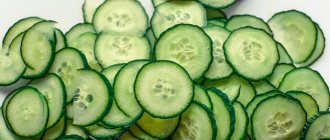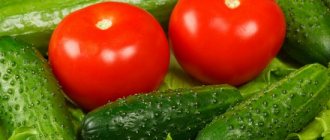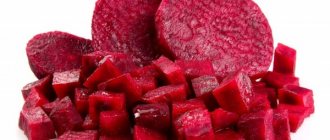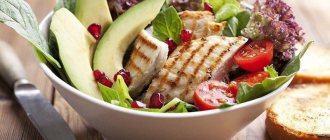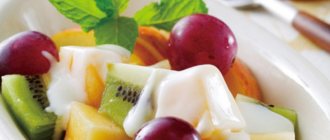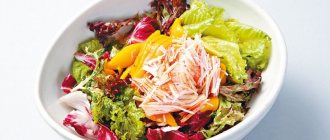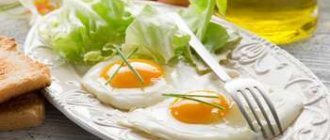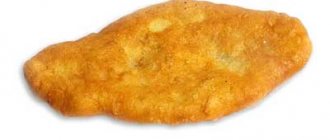How many calories:
=167 kcal.
Olivier Salad with Sausage - 167 cal. per 100 grams.
100 grams of the Olivier Salad product contains:
- Potatoes - 23 g;
- Boiled sausage - 19 g;
- Canned peas - 16 g;
- Eggs - 14 g;
- Mayonnaise - 11 g;
- Pickled cucumbers - 10 g;
- Onion - 6 g;
- Salt - 1 g;
To calculate the calorie content of the Olivier salad, pickles were taken into account. The calorie content of pickled cucumbers is higher due to their sugar content. When using them, the calorie content of the dish will increase by about 5 calories per 100 grams. You can reduce the calorie content of the dish if you use lean meat instead of sausage. In this case, calorie content will decrease by 20 calories per 100 g.
Composition of nutrients, BJU
Olivier salad with sausage
| For quantity: 100 grams | ||
| Calories — 167 | Calories from fat - 116 | |
| BJU | ||
| Total fat content | 12.94g | |
| Saturated | 3.01g | |
| Polyunsaturated | 4.65g | |
| Monounsaturated | 5.05g | |
| Cholesterol | 91mg | |
| Total carbohydrate content | 7.13g | |
| Dietary fiber | 1.31g | |
| Sugar | 1.59g | |
| Squirrels | 5.41g | |
| Vitamins and microelements | ||
| A - 34.09 µg | C - 16.75 mg | |
| B-6 – 0.14 mg | B-12 - 0.51mcg | |
| D - 0.44 µg | E - 0.75 mg | |
| Calcium 25 µg | Iron 1.01 mg | |
| Magnesium 15.84 mg | Zinc 0.85mg | |
| Potassium 210 mg | Sodium 826 mg | |
Distribution of calories for BJU:Carbohydrates (19%) Fats (69%) Proteins (12%) | ||
How many calories are in Olivier salad?
There are very, very many varieties of Olivier, which significantly expands the answer to the question of how many calories are in 100 grams of this salad.
Therefore, we decided to choose the classic Olivier recipe, or as people also call “winter” salad, as the starting point for calculating kcal:
- Potatoes, boiled in their jackets – 4-6 tubers, which averages 600-650 g.
- Fresh short cucumbers – 2 pcs., in terms of grams – 200 g.
- Pickled (salted) cucumbers – 3-4 pcs. = 250-300 g.
- Boiled carrots – 1 root vegetable weighing 120-130 g.
- Eggs – 5 pcs. On average, one category 1 egg weighs between 55-60 g, which means that Olivier requires about 275-300 g of eggs.
- If we prepare a salad with boiled sausage (300 g), then by default we choose the milk variety, 100 g of which contains 152 kcal. If you take doctor’s or friend’s sausages, then the calorie content of such a product will be higher, but not by much, literally by 30-70 kcal.
- If the salad is prepared with meat or chicken, then on average the volume of meat product is taken larger than sausages with the expectation of weight loss during the cooking process. Usually the calculation is in 400 g. This is the weight of an average chicken breast.
- According to the standard, green peas are added to the salad in the amount of pure product from 1 jar, which is 240-250 g.
- Onion - 1 head, weighs between 70-100 g, and has a very low calorie content - 41 kcal.
- Mayonnaise is indispensable for dressing Olivier. Today there are a lot of varieties of this sauce: lean, light, and olive, but for traditional Olivier, “Provencal” mayonnaise is used, the calorie content of which is very impressive - 624 kcal per 100 g. Naturally, with mayonnaise, Olivier will have a high energy value. But if you prepare this salad without mayonnaise, and replace it, for example, with low-fat sour cream or yogurt, then the calorie content of the snack will be significantly reduced.
To determine the most optimal salad composition for you, we suggest that you familiarize yourself with the calorie table for Olivier with different dressings and meat components.
Benefits of Olivier
Olivier consists of ingredients that are quite beneficial for the body. In the classic version of preparing Olivier, the following products are used:
- Potatoes are rich in starch, which lowers cholesterol levels.
- Eggs are an optimal source of protein with almost no fat, necessary to optimize the amino acid content in muscles.
- Chicken fillet - contains healthy proteins and a small amount of animal fat, also necessary for the normal development of the body.
- cucumbers contain many vitamins, while salted ones help restore the water-salt balance, which is especially important during the holidays when you abuse alcohol.
- Green peas are a source of vegetable protein rather than animal protein.
- Carrots contain vitamin A, which helps strengthen our vision. As you know, to absorb beta-carotene, carrots must be consumed together with fats. In combination with carrots, we can mention the “healthy” properties of harmful mayonnaise, which, in this case, plays the role of fats.
The vegetable part of the recipe saturates the body with vitamins and plant fibers, which optimize the functioning of the stomach; lean poultry and eggs make the dish satisfying without causing fat deposits.
How many heh in Olivier. Is it possible to use Olivier if you have diabetes?
Olivier salad, containing a large amount of carbohydrates and dressed with mayonnaise, is not recommended for diabetics. Such heavy foods in the diet, even in small quantities, are extremely undesirable. The temptation of the holiday table is not easy to resist, we are looking for a safe version of our favorite dish.
Classic Olivier and its dangers
To assess the degree of influence of one of the most popular salads on the body, let’s try to understand the composition and what exactly it is undesirable for diabetics to consume.
- Sausage is one of the most questionable ingredients. It is too difficult to determine the amount of meat, as well as starch, soy protein, stabilizers and dyes.
- Pickles. They are often replaced with fresh ones, which is quite logical. A large amount of sugar and vinegar does not add any benefit to the dish.
- Mayonnaise is one of the most dangerous ingredients in this salad. High fat content and, as a result, calorie content, vinegar and preservatives, can turn 1 tablespoon of the product into a source of a huge dose of cholesterol.
- Potatoes, which in the classic recipe are too much for a diabetic’s diet. As, indeed, starch and, accordingly, carbohydrates.
- Canned peas. It is not advisable to consume any canned food if you have diabetes.
Based on these arguments, the most popular version of the dish is undesirable for diabetics. But there are a few more arguments worth considering.
Pros and cons of "Olivier"
This salad is loved by many because it combines both a main dish and a side dish. Its high energy value allows you to satisfy your hunger with just one heaped tablespoon. But if we talk about consumption standards, which ultimately make it possible to regulate the breakdown of substances entering the body, then in the classical version there are too many of them. For 100 grams of such a dish there will be about 7 bread units. Sausage, potatoes and mayonnaise give this indicator to a greater extent. But at the same time:
- Potatoes lower cholesterol levels;
- eggs contain protein necessary to strengthen the muscle corset;
- green peas contain a large amount of fiber.
If we talk about the light version, where high-calorie foods are replaced with those approved by nutritionists, the same 100 grams will require less than 2 bread units. This means that there is a way out of the situation; you just need to prepare the dish with a slight change in the recipe.
Dietary "Olivier" for diabetics
The principle of preparing this salad is to replace potatoes with apples, and sausages with boiled chicken fillet. In addition, mayonnaise must be replaced with yogurt dressing.
To get the “right Olivier” you will need:
- 1 chicken fillet;
- 3 eggs;
- 1 apple;
- 1 lightly salted cucumber;
- 1 can of peas.
For refueling:
- 150 grams of natural yogurt;
- 1 tablespoon apple cider vinegar;
- salt, sweetener and other spices.
Boil the fillet and eggs until fully cooked. Cut the fillet, apple, eggs and cucumber into cubes. Drain liquid from peas. Mix all ingredients.
Mix yogurt with apple cider vinegar and spices. Add dressing to taste and mix thoroughly. If desired, you can add finely chopped greens to the salad.
"Olivier" with veal
This recipe is suitable for type 1 diabetics as it contains small amounts of carrots and potatoes, which can raise blood sugar levels.
To prepare this version you need:
- 300 grams of boiled veal;
- 4 boiled eggs;
- 1 can of peas;
- 1 apple;
- 1 cucumber;
- 1 baked potato;
- 1 baked carrot.
For the sauce:
- sour cream 10% fat;
- 1 teaspoon lemon juice;
- spices and salt.
All ingredients are cut into small cubes, mixed and seasoned with a mixture of sour cream and lemon juice.
Another recipe for your favorite salad for the holiday table without fatty dressings and sausage. The taste of the dish will remain virtually unchanged, but adverse consequences from consumption will be avoided.
Why you should stop experimenting
Still, such a mixture of products is not suitable for everyone. People with type 2 diabetes should carefully monitor their diet, especially during periods of unstable condition. In case of hypoglycemia, a light dietary version of salad is quite acceptable to raise the fallen blood glucose level.
Many diabetics are prone to digestive disorders. Experimenting with mixing protein products with high-carbohydrate foods seasoned with fermented milk sauce is not the best choice for a weakened body.
The difference in food processing time is unfavorable for diabetics. If the apple takes about 1 hour, the meat will take about 3-4 to digest. Natural fermentation processes will provoke not only discomfort, but also increased gas formation, and with it heaviness and painful sensations in the abdominal area.
From the above it follows that such complex dishes with a large number of ingredients are not very useful for an organism weakened by disease. And if you really want to indulge in some of your favorite salad during the holidays, then it should be a light version with a serving not exceeding 150 grams.
Olivier recipe with chicken. Calorie, chemical composition and nutritional value.
Nutritional value and chemical composition of Olivier with Chicken.
The table shows the nutritional content (calories, proteins, fats, carbohydrates, vitamins and minerals) per 100 grams of edible portion.
| Nutrient | Quantity | Norm** | % of the norm in 100 g | % of the norm in 100 kcal | 100% normal |
| Calorie content | 156.5 kcal | 1684 kcal | 9.3% | 5.9% | 1076 g |
| Squirrels | 8.1 g | 76 g | 10.7% | 6.8% | 938 g |
| Fats | 10.8 g | 56 g | 19.3% | 12.3% | 519 g |
| Carbohydrates | 6.5 g | 219 g | 3% | 1.9% | 3369 g |
| Alimentary fiber | 0.8 g | 20 g | 4% | 2.6% | 2500 g |
| Water | 72 g | 2273 g | 3.2% | 2% | 3157 g |
| Ash | 1.941 g | ~ | |||
| Vitamins | |||||
| Vitamin A, RE | 285.4 mcg | 900 mcg | 31.7% | 20.3% | 315 g |
| Retinol | 0.037 mg | ~ | |||
| alpha carotene | 1.587 mcg | ~ | |||
| beta carotene | 1.488 mg | 5 mg | 29.8% | 19% | 336 g |
| beta Cryptoxanthin | 3.663 mcg | ~ | |||
| Lutein + Zeaxanthin | 3.419 mcg | ~ | |||
| Vitamin B1, thiamine | 0.06 mg | 1.5 mg | 4% | 2.6% | 2500 g |
| Vitamin B2, riboflavin | 0.111 mg | 1.8 mg | 6.2% | 4% | 1622 g |
| Vitamin B4, choline | 54.39 mg | 500 mg | 10.9% | 7% | 919 g |
| Vitamin B5, pantothenic | 0.586 mg | 5 mg | 11.7% | 7.5% | 853 g |
| Vitamin B6, pyridoxine | 0.188 mg | 2 mg | 9.4% | 6% | 1064 g |
| Vitamin B9, folates | 4.716 mcg | 400 mcg | 1.2% | 0.8% | 8482 g |
| Vitamin B12, cobalamin | 0.118 mcg | 3 mcg | 3.9% | 2.5% | 2542 g |
| Vitamin C, ascorbic acid | 5.21 mg | 90 mg | 5.8% | 3.7% | 1727 g |
| Vitamin D, calciferol | 0.304 mcg | 10 mcg | 3% | 1.9% | 3289 g |
| Vitamin E, alpha tocopherol, TE | 4.182 mg | 15 mg | 27.9% | 17.8% | 359 g |
| Vitamin H, biotin | 2.788 mcg | 50 mcg | 5.6% | 3.6% | 1793 |
| Vitamin K, phylloquinone | 2.8 mcg | 120 mcg | 2.3% | 1.5% | 4286 g |
| Vitamin RR, NE | 2.032 mg | 20 mg | 10.2% | 6.5% | 984 g |
| Niacin | 1.984 mg | ~ | |||
| Macronutrients | |||||
| Potassium, K | 253.78 mg | 2500 mg | 10.2% | 6.5% | 985 g |
| Calcium, Ca | 30.12 mg | 1000 mg | 3% | 1.9% | 3320 g |
| Magnesium, Mg | 30.6 mg | 400 mg | 7.7% | 4.9% | 1307 g |
| Sodium, Na | 498.32 mg | 1300 mg | 38.3% | 24.5% | 261 g |
| Sera, S | 80.97 mg | 1000 mg | 8.1% | 5.2% | 1235 g |
| Phosphorus, P | 87.2 mg | 800 mg | 10.9% | 7% | 917 g |
| Chlorine, Cl | 457.8 mg | 2300 mg | 19.9% | 12.7% | 502 g |
| Microelements | |||||
| Iron, Fe | 1.094 mg | 18 mg | 6.1% | 3.9% | 1645 g |
| Yod, I | 3.53 mcg | 150 mcg | 2.4% | 1.5% | 4249 g |
| Cobalt, Co | 3.068 mcg | 10 mcg | 30.7% | 19.6% | 326 g |
| Manganese, Mn | 0.0581 mg | 2 mg | 2.9% | 1.9% | 3442 g |
| Copper, Cu | 84.06 mcg | 1000 mcg | 8.4% | 5.4% | 1190 g |
| Molybdenum, Mo | 2.47 mcg | 70 mcg | 3.5% | 2.2% | 2834 g |
| Selenium, Se | 9.032 mcg | 55 mcg | 16.4% | 10.5% | 609 g |
| Fluorine, F | 21.24 mcg | 4000 mcg | 0.5% | 0.3% | 18832 |
| Chromium, Cr | 2.47 mcg | 50 mcg | 4.9% | 3.1% | 2024 |
| Zinc, Zn | 0.5089 mg | 12 mg | 4.2% | 2.7% | 2358 g |
| Digestible carbohydrates | |||||
| Starch and dextrins | 4.616 g | ~ | |||
| Mono- and disaccharides (sugars) | 1.7 g | max 100 g | |||
| Glucose (dextrose) | 0.063 g | ~ | |||
| Fructose | 0.067 g | ~ | |||
| Essential amino acids | |||||
| Arginine* | 0.455 g | ~ | |||
| Valin | 0.324 g | ~ | |||
| Histidine* | 0.327 g | ~ | |||
| Isoleucine | 0.282 g | ~ | |||
| Leucine | 0.492 g | ~ | |||
| Lysine | 0.655 g | ~ | |||
| Methionine | 0.112 g | ~ | |||
| Methionine + Cysteine | 0.215 g | ~ | |||
| Threonine | 0.276 g | ~ | |||
| Tryptophan | 0.095 g | ~ | |||
| Phenylalanine | 0.264 g | ~ | |||
| Phenylalanine+Tyrosine | 0.484 g | ~ | |||
| Nonessential amino acids | |||||
| Alanin | 0.324 g | ~ | |||
| Aspartic acid | 0.484 g | ~ | |||
| Hydroxyproline | 0.052 g | ~ | |||
| Glycine | 0.23 g | ~ | |||
| Glutamic acid | 0.721 g | ~ | |||
| Proline | 0.251 g | ~ | |||
| Serin | 0.252 g | ~ | |||
| Tyrosine | 0.224 g | ~ | |||
| Cysteine | 0.107 g | ~ | |||
| Sterols (sterols) | |||||
| Cholesterol | 93.38 mg | max 300 mg | |||
| Phytosterols | 1.709 mg | ~ | |||
| beta sitosterol | 17.006 mg | ~ | |||
| Saturated fatty acids | |||||
| Saturated fatty acids | 1.6 g | max 18.7 g | |||
| 14:0 Miristinovaya | 0.004 g | ~ | |||
| 16:0 Palmitinaya | 0.693 g | ~ | |||
| 18:0 Stearic | 0.388 g | ~ | |||
| 20:0 Arakhinovaya | 0.029 g | ~ | |||
| 22:0 Begenovaya | 0.06 g | ~ | |||
| Monounsaturated fatty acids | 2.808 g | min 16.8 g | 16.7% | 10.7% | |
| 16:1 Palmitoleic | 0.04 g | ~ | |||
| 17:1 Heptadecene | 0.002 g | ~ | |||
| 18:1 Oleic (omega-9) | 2.26 g | ~ | |||
| Polyunsaturated fatty acids | 5.947 g | from 11.2 to 20.6 g | 53.1% | 33.9% | |
| 18:2 Linolevaya | 5.186 g | ~ | |||
| 18:3 Linolenic | 0.012 g | ~ | |||
| 20:4 Arachidonic | 0.005 g | ~ | |||
| Omega-6 fatty acids | 5.4 g | from 4.7 to 16.8 g | 100% | 63.9% |
The energy value of Olivier with chicken is 156.5 kcal.
Primary Source: Created in the application by the user. Read more.
** This table shows the average levels of vitamins and minerals for an adult. If you want to know the norms taking into account your gender, age and other factors, then use the “My Healthy Diet” application.

